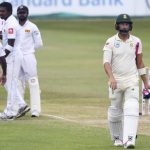Are Proteas searching in vain for mythical No. 7?
The South African team is preoccupied with the No. 7 batting slot for this year’s ICC Cricket World Cup in the UK. But how crucial is this position in the tournament?
Author:
2 March 2019

Humankind’s obsession with the number seven dates back to biblical times and beyond. There are seven deadly sins, the seventh day is the day of rest for Jewish people and Muslims walk around the Kaaba in Mecca seven times.
There are seven colours in the rainbow, seven continents and seven days of the week. In Chinese culture, the number represents the harmony between yin and yang, and the five elements of water, fire, earth, wood and metal.
You get the idea. It’s an enigmatic number, whether you’re religious or not.
The South African cricket team finds the number impossible to detach from their thoughts, although not for superstitious reasons. The Proteas’ preoccupation with the No. 7 batting position is piqued by the need to establish balance in a team that must be assembled, piece by piece, to win the Cricket World Cup in the United Kingdom on 14 July.
Related article:
In tournament cricket, the wrong balance could be exposed in a split second. And with just five one-day internationals left during which to experiment, time is running out for a few Proteas hopefuls.
But how important is a No. 7 batsman really, in the context of one-day cricket and – more importantly – World Cup cricket? Depending on who you ask, it’s the difference between arresting a batting decline, choking in a critical period of a match or seizing a moment by the short and curlies to win the most coveted prize in cricket. If the team is good enough, the No. 7 batsman’s contribution may go unnoticed.
Exorcising the demons of 1999
At this juncture in South African cricket history, it is about the World Cup and nothing else. Jobs are on the line in the national camp. It is the last World Cup for a handful of players, another opportunity to erase the heartaches from the previous World Cup staged on British soil, in 1999.
Anything less than triumph is a failure. Given the fatalistic nature of South Africa’s World Cup past, a No. 7 batsman is the equivalent of the Heimlich manoeuvre – a way to expel any object lodged in the larynx of a potential victory.
A No. 7 batsman is the Hail Mary of batting positions: useful when all before him have capitulated, something a South African top order is susceptible to these days. In football terms, a No. 7 batsman is the equivalent of a No. 5, a sweeper and the last line of defence against an aggressive attack.
One-day cricket history suggests that the quality of the No. 7 batsman enhances a team’s prospects of victory. It’s the fulcrum of a successful outfit, able to swing a match with the desired momentum. Typically, a No. 7 batter would have the mental agility to assess a match situation and apply his or her particular set of skills to pursue the desired outcome.
Historically, the requirement has been to score a quickfire 30 or 40 runs to seal a victory. Past masters of this craft include Pakistan’s Abdul Razzaq and Shahid Afridi, South Africa’s Shaun Pollock and New Zealand’s Chris Harris.
Today, this breed of player seems rare and they find themselves the subjects of intense search missions. The influence of the powerplay in one-day cricket has seen more batting collapses at the top of the order, making the all-important No. 7 position that much more coveted.
A position for versatile players
Naturally, No. 7 batsmen tend to be able to contribute in other ways, too, or risk being labelled as passengers taking up space that could be reserved for another strike bowler. Razzaq’s record is arguably better than Harris’. Razzaq has a century at No. 7, which Harris doesn’t have batting in that position. In fact, there’s only one other batsman in the top 12 best No. 7s who has managed a ton in that position: Pollock.
Pollock’s 130 runs off 110 balls for the Africa XI against an Asia XI in Bengaluru in 2007 remains one of the great No. 7 innings, albeit for a losing cause in the Afro-Asia Cup. Pollock arrived at the crease after a spectacular top-order collapse left the Africa XI reeling on 31/5, and proceeded to hit 19 fours and a six in 165 minutes. Asia XI ultimately prevailed in that match by 34 runs.
Ironically, days later, MS Dhoni – arguably India’s best batsman from No. 6 onwards – outshone Pollock at No. 7, scoring 139 not out off 97 balls at a strike rate of 143.29, in the last match of the series in Chennai. Dhoni started batting with the Asia XI struggling on 72/5 in the 17th over and carried his bat after a 218-run partnership with Sri Lanka’s Mahela Jayawardene. It may have been a obscure series, but it showcased how the right No. 7 batsman can sway an outcome in one-day cricket.
First No. 7 to reach 2 000 runs
Harris was a genuine one-day all-rounder and statistically one of the more successful. The Canterbury-born journeyman has scored a world record 2 130 runs in one-day international (ODI) cricket batting at No. 7. He was the first batsman to reach 2 000 runs batting in that position.
Harris notched up 62 not-outs in his ODI career, proving his uncanny ability to close out a match. The left-handed batsman and right-arm medium pacer helped himself to 203 wickets in his 250 ODI matches at an economy rate of 4.28 runs per over, a solid return for New Zealand’s second-highest wicket-taker behind Daniel Vettori.
Assuming Dhoni will not be cloned in our lifetime, who is South Africa’s Harris and do they have a new Pollock in their ranks?
Related article:
Proteas captain Faf du Plessis and coach Ottis Gibson have, for the better part of the past six months, been speaking about their exhaustive search for the perfect candidate. Perfection being a batsman consistently able to score half-centuries and more with a useful strike rate, one who can also snatch wickets at regular intervals.
“We know with our four-bowler attack that there is enough X-factor in our bowling, but it is also a long tail,” Du Plessis has said. “We will look at the strength of the all-rounder from a batting point of view. No. 7 is important from a runs point of view … It’s 70% batting, 30% bowling. You have to look at the fact that you’re playing in England. If you’re three [wickets] down [early], then a bowling all-rounder at seven with a tail like ours, you’re potentially exposing yourself to something that can go wrong.”
Pretorius, Phehlukwayo or Philander?
With 13 weeks and just five ODIs before South Africa’s World Cup opener against hosts England on 30 May at The Oval, these searching questions and permutations are growing with intensity in the Proteas camp.
Having used 17 players during the ODI series against Pakistan, South Africa have given all pretenders a shot at making the No. 7 berth their own. None so far have convincingly claimed the position, although Dwaine Pretorius and Andile Phehlukwayo will count as the frontrunners – but only just. Both are considered bowling all-rounders with above average potential to contribute with the bat. Not quite the 70/30 split Du Plessis is searching for.
Phehlukwayo batted just twice against Pakistan, with a top score of 69 not out and best bowling figures of 4/22. Pretorius didn’t bat against Pakistan and took just two wickets.
With every match, more and more names are thrown into the pot in the hope that the Proteas will somehow find the right combination: Chris Morris, Wiaan Mulder, Farhaan Behardien, Heinrich Klaasen and a certain Vernon Philander.
Former Proteas vice-captain Ashwell Prince has been a fervent supporter of Philander’s inclusion in the World Cup squad despite concerns over his fitness and worthiness with the bat. Given the lack of clear favourites, Philander lurks with an outside chance of making the cut.
“Vernon Philander is a world-class cricketer,” Prince told SACricketmag.com. “He doesn’t get a lot of credit for his batting. People are throwing all sorts of names of potential No. 7s for South Africa to the World Cup, but [not] Vernon Philander’s name.”
What Philander offers in the bowling department in English conditions may prove tempting for selectors, but he’s not a No. 7 batsman that fits the requirements of the team at present. Added to this, the sheer intensity of World Cup tournament cricket may be punishing on Philander’s ailing body, as evidenced in 2015, which is a risk for a team desperate to win the elusive world title.
Overthinking the role
It’s possible that South Africa could be overthinking the No. 7 role. History asserts a theory that at World Cup tournaments, batsmen in that position have had a minimal impact on match results.
West Indian Darren Sammy’s 89 runs against Ireland at the 2015 World Cup is the highest score by a No. 7 in the history of the tournament. The second highest of 77, by Pakistan’s Shahid Mahboob, was scored way back in the 1983 World Cup, against Sri Lanka.
The highest score by a No. 7 batsman in the knockout stages of the 2015 World Cup in Australia and New Zealand was 30, by Bangladesh’s Sabbir Rahman, indicating that if a top order does not do the job, there is little a No. 7 can do unless he inherits a fair deal of good fortune and poor bowling.
India’s Suresh Raina, England’s Luke Wright, South Africa’s Colin Ingram and Australia’s David Hussey made telling contributions at No. 7 in the 2011 World Cup. However, in the entire tournament, the average score for a player in the position was 17.41 runs per wicket – a drop of more than 31% from the average of the No. 7 batsman in previous years.
If the Proteas accept that their top-flight batting line-up includes the likes of Hashim Amla, Quinton de Kock, Rassie van der Dussen, Reeza Hendricks, Aiden Markram, Faf du Plessis, JP Duminy and David Miller, then they would be better served focusing on getting the best six to peak at the World Cup, and negate the pressure on a No. 7 batsman who clearly hasn’t revealed himself yet.


